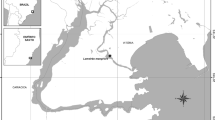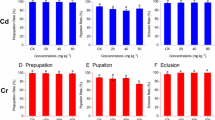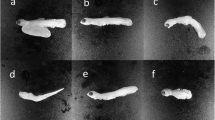Abstract
Methylmercury (meHg) inhibits limb regeneration and molting in fiddler crabs. The present study shows that, inUca pugilator from a clean site, the inhibitory effects of 0.5 Μg/ml meHg were unaffected by short term pre-exposure to low levels (0.06 or 0.1 Μg/ml) of meHg under laboratory conditions. Chronic exposure tests onUca pugnax showed that the inhibitory effects of meHg varied with the sex of the crabs and the level of contamination at the site of collection. These effects were less pronounced in crabs from an area subjected to heavy metal pollution (Piles Creek, Linden, NJ) than in crabs from a relatively cleaner area (Big Sheeps-head Creek, Tuckerton, NJ). The order of susceptibility to meHg according to its interaction with sex and site from least susceptible to most was: Piles Creek females, Piles Creek males, Tuckerton males, Tuckerton females. Residue analysis showed that all groups absorbed equivalent amounts of mercury, but only the females from Piles Creek were able to depurate to near control levels after two weeks in clean water.
Similar content being viewed by others
References
Bliss, D. E.: Neurosecretion and the control of growth in a decapod crustacean. In K. G. Wingstrand (ed.): Bertil Hanstrom. Biological papers in honour of his sixty-fifth birthday, November 20th, 1956, p. 56. Lund, Sweden: Zoological Institute (1956).
Bliss, D. E., and J. R. Boyer: Environmental regulation of growth in the decapod crustacean,Gecarcinus lateralis. Gen. Comp. Endocrinol.4, 15. (1964).
Bryan, G. W.: Some aspects of heavy metal tolerance in aquatic organisms. In A. P. M. Lockwood (ed.): Effects of pollutants on aquatic organisms, p. 7. Cambridge: Cambridge University Press (1976).
Bryan, G. W., and L. G. Hummerstone: Actaptation of the polychaeteNereis diversicolor to estuarine sediments containing high concentrations of heavy metals I. General observations and adaptations to copper. J. Mar. Biol. Assoc. U.K.51, 845 (1971).
—: Adaptation of the polychaeteNereis diversicolor to estuarine sediments containing high concentrations of zinc and cadmium. J. Mar. Biol. Assoc. U.K.53, 839 (1973a).
—: Actaptation of the polychaeteNereis diversicolor to manganese in estuarine sediments. J. Mar. Biol. Assoc. U.K.53, 859 (1973b).
Cherian, M. G., and R. A. Goyer: Metallothioneins and their role in the metabolism and the toxicity of metals. Life Sci.23, 1 (1978).
Corner, E. and B. Sparrow: The modes of action of toxic agents I. Observations of the poisoning of certain crustaceans by copper and mercury. J. Mar. Biol. Assoc. U.K.36, 459 (1956).
Cunningham, P. A., and D. S. Grosch: A comparative study of the effects of mercuric chloride and methyl-mercury chloride on reproductive performance in the brine shrimp,Artemia salina. Environ. Pollut.15, 83 (1978).
Green, F. A., Jr., J. W. Anderson, S. R. Petrocelli, B. J. Presley, and R. Sims: Effects of mercury on the survival, respiration, and growth of postlarval white shrimp,Penaeus setiferus. Mar. Biol.37, 75 (1976).
Hatch, W. R., and W. L. Ott: Determinations of submicrogram quantities of mercury by atomic absorption spectrophotometry. Anal. Chem.40, 2085 (1968).
Jennings, J. R., P. S. Rainbow, and A. G. Scott: Studies on the uptake of cadmium by the crabCarcinus maenas in the laboratory II. Preliminary investigation of cadmium-binding proteins. Mar. Biol.50, 141 (1979).
Johnson, M., and J. Gentile: Acute toxicity of cadmium, copper, mercury to larval American lobster,Homarus americanus. Bull. Environ. Contam. Toxicol.22, 258 (1979).
Koepp, S. J., J. M. McCormick, and S. L. Cheng: Distribution, flux, and biological effects of heavy metal pollutants in the Newark Bay estuary. Presented at Water Conference, Ramapo College, Mahway, NJ, May 1980.
Moraitou-Apostolopolou, M., G. Verripoulos, and P. Lentzou: Effects of sublethal concentrations of cadmium as possible indicator of cadmium pollution for two populations ofAcartia clausii (Copepoda) living at two differently polluted areas. Bull. Environ. Contam. Toxicol.23, 642 (1979).
Olafson, R. W., A. Kearns, and R. S. Sim: Heavy metal induction of metallothionein synthesis in the hepatopancreas of the crabScylla serrata. Comp. Biochem. Physiol.62B, 417 (1979).
Passano, L. M.: Molting and its control. In T. Waterman (ed.): Physiology of Crustacea. Vol I. Metabolism and growth, p. 473. New York: Academic Press (1960).
Skinner, D. M., and D. E. Graham: Loss of limbs as a stimulus to ecdysis in Brachyura (true crabs). Biol. Bull.143, 222 (1972).
Stoffel, L. A., and J. H. Hubschman: Limb loss and the molt cycle in the freshwater shrimp,Palaemonetes kadiakensis. Biol. Bull.147, 203 (1974).
Vernberg, W. B., and J. Vernberg: The synergistic effects of temperature, salinity, and mercury on survival and metabolism of the adult fiddler crab,Uca pugilator. Fish. Bull.70, 415 (1971).
Vernberg, W. B., and P. DeCoursey: Effects of mercury on survival, metabolism, and behavior of larvalUca pugilator (Brachyura). Oikos23, 241 (1972).
Weis, J. S.: Effects of environmental factors on regeneration and molting in fiddler crabs. Biol. Bull.150, 152 (1976).
—: Limb regeneration in fiddler crabs: Species differences and effect of methylmercury. Biol. Bull.152, 263 (1977).
Weis, J. S., P. Weis, M. Heber, and S. Vaidya: Methylmercury tolerance of killifish (Fundulus heteroclitus) embryos from a polluted vs non-polluted environment. Mar. Biol.65(3), 283 (1981).
Author information
Authors and Affiliations
Rights and permissions
About this article
Cite this article
Callahan, P., Weis, J.S. Methylmercury effects on regeneration and ecdysis in fiddler crabs (Uca pugilator, U. pugnax) after short-term and chronic pre-exposure. Arch. Environ. Contam. Toxicol. 12, 707–714 (1983). https://doi.org/10.1007/BF01060755
Received:
Revised:
Issue Date:
DOI: https://doi.org/10.1007/BF01060755




